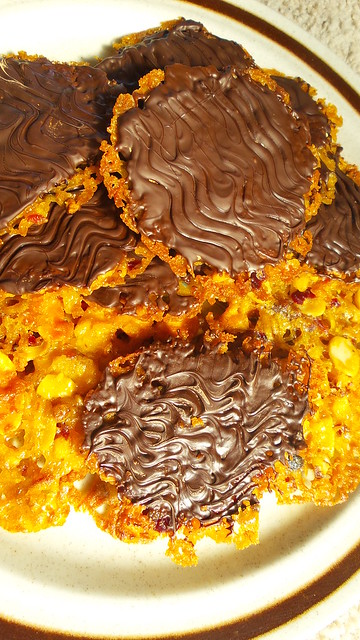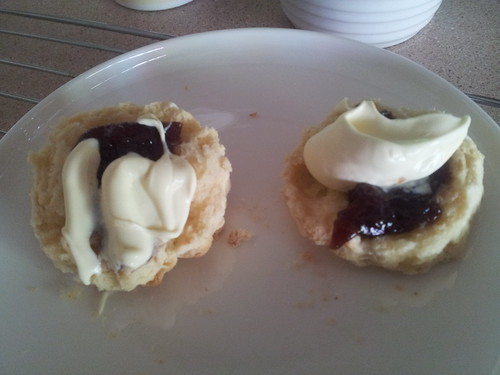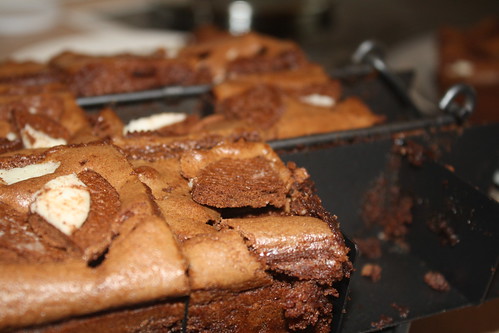The Great British Bake Off is in full swing yet again. I love this program (you can follow along here in Australia as the Guardian has a weekly live blog of the action) because it is so much more gentle than any of the other reality cooking programs (and yes, that includes you, Great Australian Bake Off, with your nasty Big Brother style approach of making the contestants live together and your snippy female judge). Mary Berry is the grandma everyone should want to have and both Mary and Paul take the time to offer constructive criticism. There’s very little nastiness in the show at all (let’s leave aside Bingate and the fallout from that).
A couple of weeks ago the technical challenge was Florentines. Personally I really like the idea of Florentines but find that when you buy them in a cafe they are plate like, thick, and sometimes contain both peanuts and glacé cherries. One of those is bad, both is awful!
On the show, Mary impressed upon the competitors that they should be aiming for lacy, delicate biscuits and there wasn’t a peanut in sight! The real challenge on the program was that the bakers had to temper chocolate for the decoration and that they weren’t told what that decoration should be. I was surprised by how many were really uncertain about this – eat more biscuits, people!
I originally made this as a candidate for the Sweet Swap. However, they were far too delicate to survive in the post, I didn’t do a brilliant job of tempering the chocolate (it was late, I did it in the microwave …) and I’d also neglected to note that one of my swapees was lactose intolerant and these biscuits contain butter. The following recipe (thanks BBC Food) is egg free but does contain flour. I love that Mary uses dried cranberries as a cherry substitute – definitely the way forward – they offer a necessary sour counterpoint to all the sugariness from the caramel biscuit base. Be sure to use baking paper on your trays and handle the biscuits very carefully when they come out of the oven. They are perfectly good to eat without their chocolate back (if you feel that might be a bit too much faff!)
Ingredients
- 50g butter
- 50g golden caster sugar
- 50g golden syrup
- 50g plain flour
- 25g dried cranberries (you might find them labelled as 'craisin')
- 50g dried/candied peel
- 25g slivered almonds
- 25g walnut pieces (you can buy these but if you are using whole/part walnuts, finely chop them)
- 200g dark chocolate
Instructions
- Heat oven to 180°C and line three baking trays with baking paper.
- Weigh butter, sugar and golden syrup into a small pan (preferably a non stick one - it will make cleaning up easier!) and heat gently to melt the butter. Remove from the heat and add the dry ingredients.
- Mix well.
- Drop teaspoonfuls of the mixture on to the prepared baking trays. This recipe makes roughly 18 - so 6 biscuits per tray. It's important to allow plenty of space between biscuits as they spread a lot!
- Bake for 8-10 minutes, or until golden brown.
- Leave them to cool on the trays for a little before using a broad palette knife and lifting them very gently and carefully onto racks to cool. You won't be stack them so make sure you have plenty of rack space.
- If using the chocolate, break half the chocolate into a bain-marie and heat to 53°C. When it hits this temperature, remove from the heat and stir in the remaining chocolate (grated or chopped) and stir gently to melt until the temperature drops to 26°C. Using a sugar thermometer can be tricky for this (they're designed for high temperatures!) so if you think you'll do this more than once, a chocolate thermometer might be a worthwhile investment.
- Spread the melted chocolate over the base of each biscuit and leave to cool slightly before creating the signature zig-zag pattern using a fork. If your biscuits are sufficiently lacy you will end up with very chocolatey hands!
- Allow to set completely and then store in an airtight container.



